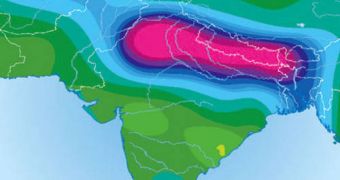In the first-of-its-kind assessment, conducted on a swath of land spanning regions in Pakistan, India and neighboring Bangladesh, it was revealed that the continent is losing groundwater reserves at an alarming rate. Specialists say that the 54 cubic kilometers of groundwater lost annually mostly goes into irrigation systems, which help sustain the crops that feed more than 600 million people living in the area. More than 2,000 kilometers of land were analyzed, and experts from the University of California in Irvine (UCI), led by hydrologist James Famiglietti, state that the number is big, ScienceNow reports.
”I don't think anybody knew how quickly it was being depleted over that large an area,” the UCI expert says of the situation. The scientific measurements were obtained from the famous GRACE satellites, which were devised in cooperation by the American space agency NASA and the German Aerospace Center. There are two of these instruments, and they travel in a “pack,” always at the same distance from each other. They essentially analyze differences that occur in the Earth's magnetic pull over certain regions. These disturbances are mostly generated by changes in the amount of water that can be found on or beneath the analyzed surface.
The satellites are also famous for detecting shifts in the way oceanic currents move, and for determining accurately that the polar ice caps are melting. Over the past six years, the largest variations in gravitational pull other than those at the poles were recorded over the Indian continent, across a 2.7-million-square-kilometer swath centered on the capital city of New Delhi.
According to a study by geophysicists Virendra Tiwari from the National Geophysical Research Institute, in Hyderabad, India, John Wahr of the University of Colorado in Boulder (UCB), and Sean Swenson of the National Center for Atmospheric Research, in Boulder, after accounting for natural variations in rain drop and other natural factors, the region was still found to be losing 54 cubic kilometers of water each year, give or take 9 cubic kilometers. Details of the investigation appear in the latest issue of the journal Geophysical Research Letters.
The research could provide inestimable help to authorities in the territory, which might, based on the scientific data, elaborate complex long-term plans to reduce this alarming trend. Otherwise, experts note, it may be that the entire region will, in a few decades, become unfit to sustain the large number of citizens who inhabit it now.

 14 DAY TRIAL //
14 DAY TRIAL //